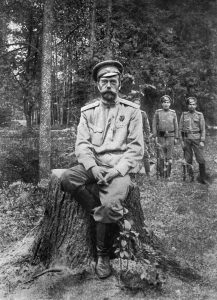The March article in my monthly series for Smithsonian Magazine about the Russian Revolutions of 1917 is about the abdication of Czar Nicholas II, which took place nearly 100 years ago on March 15, 1917. Since becoming Czar in 1894, Nicholas II had remained in power through a number of crises including Russia’s defeat in the Russo-Japanese war of 1904 and Bloody Sunday in 1905. The difference in 1917 was that Nicholas II lost the support of the military during the First World War and his generals urged him to abdicate in the interests of continuing the war on the eastern front.
Click here to read “The Abdication of Nicholas II Left Russia Without a Czar for the First Time in 300 Years” in Smithsonian Magazine
Sources and Further Reading:
After his abdication, Czar Nicholas II caught up on reading, completing War and Peace
by Leo Tolstoy for the first time while under house arrest. My article begins with a quote from the novel from Part 2, when Napoleon invaded Russia during the reign of Czar Alexander I.
Key documents concerning the abdication of Nicholas II including the telegrams from his generals, announcements by the Duma and the abdication manifesto itself are translated and reprinted in The Fall of the Romanovs: Political Dreams and Personal Struggles in a Time of Revolution
The Complete Wartime Correspondence of Tsar Nicholas II and the Empress Alexandra
has been published in its entirety. Excerpts from the Imperial couple’s letters are also printed in A Lifelong Passion: Nicholas and Alexandra: Their Own Story
Dominic Lieven’s latest book discusses The End of Tsarist Russia: The March to World War I and Revolution
. He is also the author of a political biography of Czar Nicholas II entitled Nicholas II: Twilight of the Empire








hello, can you tell me who is the royal jeweler is now it seems google cannot answer a simple question as well as other simple questions and could you also make a list of books on royal fashion and jewellry as well thank you karla kirkpatrick
I recommend visiting this site http://www.thecourtjeweller.com/ for more information about royal jewels.
The Queen appointed a new Crown Jeweller, Martin Swift, in 2012
http://www.telegraph.co.uk/news/uknews/theroyalfamily/9400601/The-Queen-appoints-new-Crown-Jeweller.html